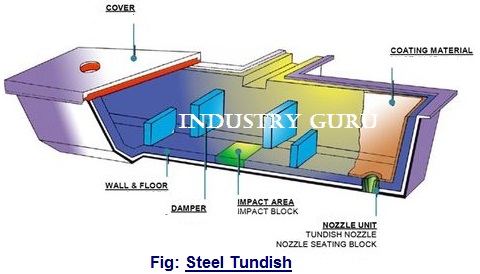17-Jun-2023
Reheating Furnaces serve the purpose of heating various intermediate products of Steel like- ingots, blooms or billets before rolling to give them different shapes of angles, channels, bars, slabs, rods & wires etc
Read: What are Reheating Furnaces Area wise specifications of Refractory Bricks and Castables or Blocks which can be used for lining of reheating furnaces and the quality of Refractory Mortar which can be used for laying the bricks are given hereunder -
Reheating Furnace Hearth
- Dense high alumina bricks with low iron content. Alumina (Al2O3) 88-90%, Iron (Fe2O3) 1.8% (max), Bulk Density (BD) 3-3.2 gm/cc, Apparent Porosity (AP) 16-18%, CCS(kg/cm2) 800 (min), RUL(taOC) around 1550-1600, PLC at 1600OC/2hrs (+/-) 0.2% (max).
- Basic Magnesia, Mag-chrome bricks. MgO around 55-60%, Chrome (Cr2O3) around 12-15%, Silica (SiO2) 8% (max), AP 18-20%, CCS (kg/cm2) around 450-500, RUL (taOC) 1600 (min), PLC at 1600OC/2hrs (+/-) 0.5% (max).
Furnace Roof
Alumina (Al2O3) around 70%, Iron (Fe2O3) around 2.5-2.8%, BD 2.6-2.7 gm/cc, AP 21-23%, CCS (kg/cm2) 500 (min), RUL (taOC) around 1450-1500, PLC at 1500OC/2hrs (+/-) 2.5% (max).
Furnace Side-Wall and for General purpose
- Low porosity dense bricks. Alumina (Al2O3) 45%, Iron (Fe2O3) 1.6-1.8%, BD around 2.2 gm/cc, AP around 16%, CCS (kg/cm2) around 500, RUL (taOC) 1500 (min).
- Alumina (Al2O3) 40%, Iron (Fe2O3) 2.0-2.2%, BD 2.1 gm/cc (min), AP 22% (max), CCS (kg/cm2) around 350, RUL (taOC) 1400 (min).
Furnace Bottom, Blocks (Burner Block, Well Block, Seating Block, Seating Well Block) and Castables
- Medium purity Low Cement Castable (LCC). Alumina (Al2O3) around 90%, Iron (Fe2O3) 1.0-1.5%, BD 2.7-2.9 gm/cc, PCE 37 Orton (min), CCS (kg/cm2) at 110OC/24hrs 600 (min), at 1500OC/3hrs 550 (min), PLC at 1500OC/2hrs (+/-) 1.0% (max).
- Medium purity Castable conventional type. Alumina (Al2O3) around 60%, Iron (Fe2O3) 1.8% (max), BD 2.1 gm/cc (min), PCE 36 Orton (min), CCS (kg/cm2) at 110OC/24hrs 350 (min), at 1500OC/3hrs 450 (min), PLC at 1500OC/3hrs (+/-) 1.5% (max).
Furnace Door, Flue Stack, Heaters
Insulating Castables. Iron 1% (max), BD 1.0-1.2 gm/cc, CCS (kg/cm2) at 110OC/24hrs around 12-15.
Mortars
Have to be compatible with the laying brick quality (chemical spec).
All the data given above are tentative and should not be considered as ‘Typical Specification Data’.
Methods of installation (Read: Refractory Installation Procedure and Heating Schedule to be followed after starting a Furnace) may be provided by the refractory supplier.












